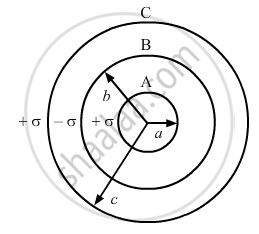Advertisements
Advertisements
प्रश्न
In an electric circuit containing a battery, the charge (assumed positive) inside the battery ____________ .
विकल्प
always goes from the positive terminal to the negative terminal
may go from the positive terminal to the negative terminal
always goes from the negative terminal to the positive terminal
does not move
उत्तर
may go from the positive terminal to the negative terminal
In the study of electric current, the direction opposite the flow of electrons is regarded as the direction of flow of positive charge. In a battery, positive charge flows from the negative terminal to the positive terminal when it is discharging (connected to external circuit). But when the battery is charged, the positive charge flows from the positive terminal to the negative terminal.
APPEARS IN
संबंधित प्रश्न
A charge Q is distributed uniformly over a metallic sphere of radius R. Obtain the expressions for the electric field (E) and electric potential (V) at a point 0 < x < R.
Show on a plot the variation of E and V with x for 0 < x < 2R.
Three concentric metallic shells A, B and C or radii a, b and c (a < b < c) have surface charge densities + σ, −σ and + σ, respectively as shown in the figure

If shells A and C are at the same potential, then obtain the relation between the radii a, b and c.
Sunita and her friends visited the exhibition. The policeman asked them to pass through a metal detector. Sunita's friends were initially scared of it. Sunita, however, explained to them the purpose and working of the metal detector.
Answer the following questions :
(a) On what principle does a metal detector work?
(b) Why does the detector emit a sound when a person carrying any metallic object walks through it?
(c) State any two qualities which Sunita displayed while explaining the purpose of walking through the detector.
A constant voltage is applied between the two ends of a uniform metallic wire. Some heat is developed in it. The heat developed is doubled if ______.
If the resistivity of an alloy is P and that of constitute metal is P1 then
A steady current of 1 A is flowing through the conductor. The number of electrons flowing through the cross-section of the conductor in 1 second is ______
For wiring in the home, one uses Cu wires or Al wires. What considerations are involved in this?
An electric current (I) flowing through a metallic wire is gradually increased. The graph of heating power (P) developed in it versus the current (I) is ______.
Current I flowing through a metallic wire is gradually increased. Show graphically how heating power (P) developed in it varies with the current (I).
